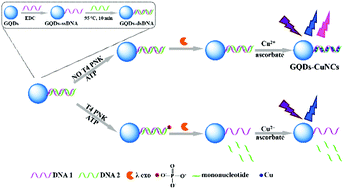Ratio fluorescence analysis of T4 polynucleotide kinase activity based on the formation of a graphene quantum dot–copper nanocluster nanohybrid†
Abstract
In this work, a ratio fluorescence method was developed for T4 polynucleotide kinase (PNK) activity analysis based on the formation of a dual-emitting graphene quantum dot–copper nanocluster (GQD–CuNC) nanohybrid. An amino capped single-strand DNA (ssDNA) was firstly used to modify GQDs (GQD-ssDNA) and then hybridize with its complementary DNA strand to form double-stranded DNA functionalized GQDs (GQD-dsDNA). The dsDNA of GQD-dsDNA can act as an effective template for the preparation of CuNCs with fluorescence emission at 594 nm. When the dsDNA of GQD-dsDNA was phosphorylated through T4 PNK and subsequently degraded via λ exonuclease (λ exo) to produce mononucleotides and GQD-ssDNA, the formation of fluorescence CuNCs in GQD-CuNCs was blocked due to the lack of an effective dsDNA substrate, during which the fluorescence of GQDs at 446 nm in the nanohybrid was mostly not influenced. Thus, with the CuNCs serving as the reporter and GQDs as the reference signal, T4 PNK activity can be monitored through the change in the fluorescence intensity ratio (F594/F446) in the range of 0.01–10 U mL−1 with a detection limit (LOD) of 0.0037 U mL−1. Furthermore, the practicality of this T4 PNK activity analysis strategy in a complex sample was tested in cell lysates.



 Please wait while we load your content...
Please wait while we load your content...